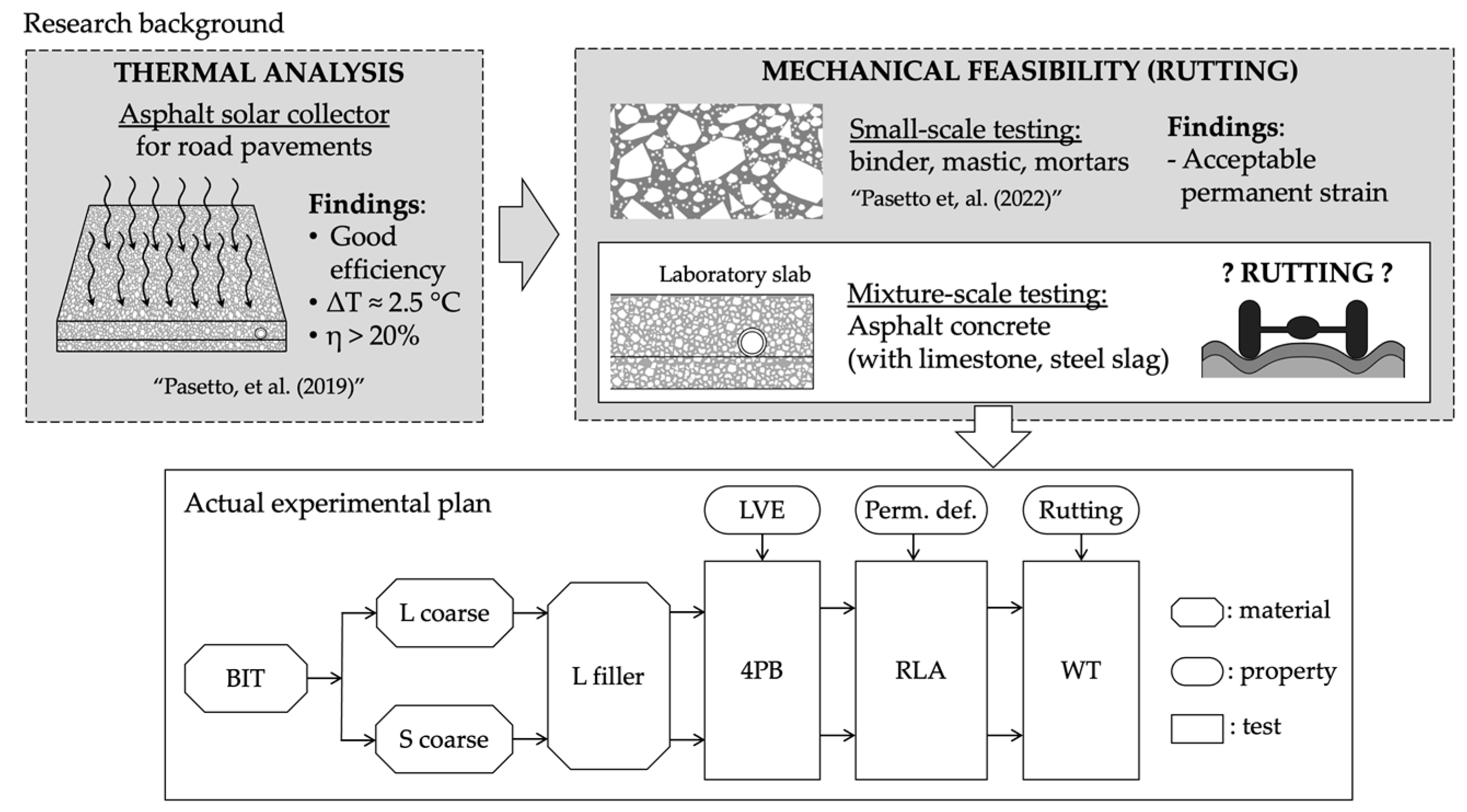Rutting Behavior of Asphalt Surface Layers Designed for Solar Harvesting Systems
Abstract
1. Introduction
2. Research Objectives and Approach
- a bottom asphalt layer prepared with an 8 mm maximum aggregate size dense-graded bituminous mixture representative of the existing road pavement;
- a steel collector for a fluid circulation placed at the interface;
- a top 4 cm thick asphalt layer prepared with an 8 mm maximum aggregate size dense-graded bituminous mixture compacted at 4% air voids to maximize the heat transfer within the pavement.
- quite thin thickness (4 cm), to reduce the installation depth of the collector;
- small nominal maximum aggregate size (NMAS) suitable for thin-layers;
- quite low void contents (fixed at 4%), to reduce the insulating air pore structure.
3. Materials and Methods
3.1. Materials
3.2. Sample Preparation
3.3. Testing Methods
4. Experimental Results and Analysis
4.1. Laboratory Results
4.2. Discussion
5. Conclusions and Further Studies
- in terms of visco-elastic properties, steel slag led to an appreciable stiffening effect and a slightly higher viscous behavior with respect to reference bituminous mixtures containing natural limestone aggregate only. The double-layer samples containing the solar collector were always stiffer than the corresponding standard double-layer structure. This result was initially supposed to be beneficial in terms of permanent deformation resistance;
- as expected, permanent deformation test results were in accordance with what was found in terms of stiffness (i.e., the higher the stiffness, the lower the permanent deformation of the materials);
- despite a relatively superficial installation of the collector, which was placed only 28 mm under the surface based on thermal optimization, no differential rutting influenced by the metallic elements was detected during wheel tracking tests. This was verified both for limestone- and slag-based asphalt mixes;
- in absolute terms, the final rut depths produced on the slab surfaces (both in the case of limestone and steel slag) did not match the minimum technical requirements related to rutting resistance; in the same way, the final covering thickness of asphalt above the collector was unacceptable because of the excessive rutting;
- thus, specific suggestions were provided to redesign the mixes towards more rutting-resistant structures while maintain thermal efficiency; in this sense, the optimization of the aggregate gradations and the binder content along with the use of polymer-modified bitumen were identified as possible improvements.
Author Contributions
Funding
Institutional Review Board Statement
Informed Consent Statement
Data Availability Statement
Conflicts of Interest
References
- Zou, G.; Xu, J.; Wu, C. Evaluation of factors that affect rutting resistance of asphalt mixes by orthogonal experiment design. Int. J. Pavement Res. Technol. 2017, 10, 282–288. [Google Scholar] [CrossRef]
- Raffaniello, A.; Bauer, M.; Safiuddin, M.; El-Hakim, M. Traffic and climate impacts on rutting and thermal cracking in flexible and composite pavements. Infrastructures 2022, 7, 100. [Google Scholar] [CrossRef]
- Alamnie, M.M.; Taddesse, E.; Hoff, I. Advances in permanent deformation modeling of asphalt concrete—A review. Materials 2022, 15, 3480. [Google Scholar] [CrossRef] [PubMed]
- Zhang, W.; Huang, X.; Yang, J.; Chen, X. RETRACTED: Effect of segregation on rutting resistance of asphalt pavement. Constr. Build. Mater. 2017, 147, 525–532. [Google Scholar] [CrossRef]
- Alkaissi, Z.A. Effect of high temperature and traffic loading on rutting performance of flexible pavement. J. King Saud Univ. Eng. Sci. 2020, 32, 1–4. [Google Scholar] [CrossRef]
- Zhang, J.; Alvarez, A.E.; Lee, S.I.; Torres, A.; Walubita, L.F. Comparison of flow number, dynamic modulus, and repeated load tests for evaluation of HMA permanent deformation. Constr. Build. Mater. 2013, 44, 391–398. [Google Scholar] [CrossRef]
- Ferreira, J.L.; Babadopulos, L.F.; Bastos, J.B.; Soares, J.B. A tool to design rutting resistant asphalt mixes through aggregate gradation selection. Constr. Build. Mater. 2020, 236, 117531. [Google Scholar] [CrossRef]
- Hamid, A.; Baaj, H.; El-Hakim, M. Rutting behaviour of geopolymer and styrene butadiene styrene-modified asphalt binder. Polymers 2022, 14, 2780. [Google Scholar] [CrossRef]
- Naqibah, S.N.; Hainin, M.R.; Idham, M.K.; Warid, N.M.; Hassan, N.A.; Mohamed, A.; Paun, O.C.; Ismail, R. Performance of rutting, stripping and cracking of warm mix asphalt. Mater. Sci. Eng. 2019, 527, 012062. [Google Scholar] [CrossRef]
- Arshad, A.K.; Ali, N.A.; Shaffie, E.; Hashim, W.; Rahman, Z.A. Rutting performance of cold bituminous emulsion mixtures. AIP Conf. Proc. 2017, 1892, 050001. [Google Scholar]
- Correia, N.S.; Zrnberg, J.G. Mechanical response of flexible pavements enhanced with geogrid-reinforced asphalt overlays. Geosynth. Int. 2016, 23, 183–193. [Google Scholar] [CrossRef]
- Witczak, M.; Kaloush, K.; Pellinen, T.; Quintus, H.V. Simple Performance Test for Superpave Mix Design; National Academy Press: Washington, DC, USA, 2002. [Google Scholar]
- Test, T. Determination of the Track Depth of High-Stability Binding Layers, Construction Bureau; Civil Engineering Office, Department of City Traffic: Hamburg, Germany, 1991.
- Saevarsdottir, T.; Erlingsson, S. Modelling of responses and rutting profile of a flexible pavement structure in a heavy vehicle simulator test. Road Mater. Pavement Des. 2015, 16, 1–18. [Google Scholar] [CrossRef]
- Lv, Q.; Huang, W.; Zheng, M.; Sadek, H.; Zhang, Y.; Tyan, C. Influence of gradation on asphalt mix rutting resistance measured by Hamburg Wheel Tracking test. Constr. Build. Mater. 2020, 238, 117674. [Google Scholar] [CrossRef]
- Javilla, B.; Fang, H.; Mo, L.; Shu, B.; Wu, S. Test evaluation of rutting performance indicators of asphalt mixtures. Constr. Build. Mater. 2017, 155, 1215–1223. [Google Scholar] [CrossRef]
- Nejad, F.M.; Mirzahosseini, M.; Novin, M.K.; Abedi, H. The effects of bitumen percentage and percentage of air void on rutting potential of HMA by using of dynamic creep test. In Proceedings of the 10th Annual International Conference on Sustainable Construction & Pavement Engineering, Liverpool, UK, 16–17 February 2011. [Google Scholar]
- Ouni, A.E.; Dony, A.; Colin, J. Probabilistic parametric approach for rutting evaluation: Application to hot and warm asphalt. Int. J. Pavement Eng. 2012, 15, 58–65. [Google Scholar] [CrossRef]
- Topal, A.; Sengoz, B. Determination of fine aggregate angularity in relation with the resistance to rutting of hot-mix asphalt. Constr. Build. Mater. 2005, 19, 155–163. [Google Scholar] [CrossRef]
- Lira, B.; Ekblad, J.; Lundström, R. Evaluation of asphalt rutting based on mixture aggregate gradation. Road Mater. Pavement Des. 2019, 22, 1160–1177. [Google Scholar] [CrossRef]
- Autelitano, F.; Giuliani, F. Swelling behavior of electric arc furnace aggregates for unbound granular mixtures in road construction. Int. J. Pavement Res. Technol. 2015, 8, 103–111. [Google Scholar]
- Proctor, D.M.; Fehling, K.A.; Shay, E.C.; Wittenborn, J.L.; Green, J.L.; Avent, C.; Bigham, R.D.; Connolly, M.; Lee, B.; Shepker, T.O.; et al. Physical and chemical characteristics of blast furnace, basic oxygen furnace, and electric arc furnace steel industry slags. Environ. Sci. Technol. 2000, 34, 1576–1582. [Google Scholar] [CrossRef]
- Oluwasola, E.A.; Hainin, R.M.; Aziz, M.A. Characteristics and utilization of steel slag in road construction. J. Teknol. 2014, 70, 1–7. [Google Scholar] [CrossRef]
- Skaf, M.; Manso, J.M.; Aragón, Á.; Fuente-Alonso, J.A.; Ortega-López, V. EAF slag in asphalt mixes: A brief review of its possible re-use. Resour. Conserv. Recycl. 2017, 120, 176–185. [Google Scholar] [CrossRef]
- Huang, Y.; Bird, R.; Heidrich, O. A review of the use of recycled solid waste materials in asphalt pavements. Resour. Conserv. Recycl. 2007, 52, 58–73. [Google Scholar] [CrossRef]
- Pasetto, M.; Baldo, N. Resistance to permanent deformation of base courses asphalt concretes made with RAP aggregate and steel slag. In Asphalt Pavements, 1st ed.; Kim, R.T., Ed.; CRC Press: Boca Raton, FL, USA, 2014. [Google Scholar]
- Bobes-Jesus, V.; Pascual-Muñoz, P.; Castro-Fresno, D.; Rodriguez-Hernandez, J. Asphalt solar collectors: A literature review. Appl. Energy 2013, 102, 962–970. [Google Scholar] [CrossRef]
- Hossain, M.F.T.; Dessouky, S.; Biten, A.B.; Montoya, A.; Fernandez, D. Harvesting solar energy from asphalt pavement. Sustainability 2021, 13, 12807. [Google Scholar] [CrossRef]
- Pascual-Muñoz, P.; Castro-Fresno, D.; Serrano-Bravo, P.; Alonso-Estébanez, A. Thermal and hydraulic analysis of multilayered asphalt pavements as active solar collectors. Appl. Energy 2013, 111, 234–332. [Google Scholar] [CrossRef]
- Bejan, A.; Kraus, A.D. Heat Transfer Handbook; Wiley: Hoboken, NJ, USA, 2003. [Google Scholar]
- Pasetto, M.; Baliello, A.; Galgaro, A.; Mogentale, E.; Sandalo, A. Preliminary study of an energy harvesting system for road pavements made with marginal aggregate. In Lecture Notes in Civil Engineering; Springer: Cham, Switzerland, 2019; Volume 48, pp. 101–113. [Google Scholar]
- Pasetto, M.; Baliello, A.; Giacomello, G.; Pasquini, E. Mechanical feasibility of asphalt materials for pavement solar collectors: Small-scale laboratory characterization. Appl. Sci. 2022, 13, 358. [Google Scholar] [CrossRef]
- Pasetto, M.; Baliello, A.; Giacomello, G.; Pasquini, E. Sustainable solutions for road pavements: A multi-scale characterization of warm mix asphalts containing steel slags. J. Clean. Prod. 2017, 166, 835–843. [Google Scholar] [CrossRef]
- Williams, M.L.; Landel, R.F.; Ferry, J.D. The temperature dependence of relaxation mechanisms in amorphous polymers and other glass-forming liquids. J. Am. Chem. Soc. 1955, 77, 3701–3707. [Google Scholar] [CrossRef]
- Ahmedzade, P.; Sengoz, B. Evaluation of steel slag coarse aggregate in hot mix asphalt concrete. J. Hazard Mater. 2019, 165, 300–605. [Google Scholar] [CrossRef]
- Ameri, M.; Hesami, S.; Goli, H. Laboratory evaluation of warm mix asphalt mixtures containing electric arc furnace (EAF) steel slag. Constr. Build. Mater. 2013, 49, 611–617. [Google Scholar] [CrossRef]
- Yi, H.; Xu, G.; Cheng, H.; Wang, J.; Wan, Y.; Chen, H. An overview of utilization of steel slag. Procedia Environ. Sci. 2012, 16, 791–801. [Google Scholar] [CrossRef]
- Bahia, H.U.; Hanson, D.I.; Zeng, M.; Zhai, H.; Khatri, M.A.; Anderson, R.M. Characterization of Modified Asphalt Binders in Superpave Mix Design; Transporatation Research Board: Washington, DC, USA, 2011. [Google Scholar]
- Blazejowski, K.; Olszacki, J.; Peciakowski, H.; Wójcik-Wiśniewska, M. Testing of bitumen-aggregate affinity by various methods. In Proceedings of the 6th Eurasphalt & Eurobitume Congress, Prague, Czech Republic, 1–3 June 2016. [Google Scholar]
- Khalid, A.G.; Bara’W, A.-M.; Ahmed, S.A.-M. Rutting performance of asphalt mixtures with gradations designed using Bailey and conventional Superpave methods. Constr. Build. Mater. 2020, 261, 119941. [Google Scholar]
- Du, Y.; Chen, J.; Han, Z.; Liu, W. A review on solutions for improving rutting resistance of asphalt pavement and test methods. Constr. Build. Mater. 2018, 168, 893–905. [Google Scholar] [CrossRef]
- Rebbechi, J.; Youdale, G. Light Duty Asphalt Pavements—Design, Specification and Construction; Australian Asphalt Pavement Association: Victoria, Australia, 2020. [Google Scholar]
- Garcia, J.; Hansen, K. HMA Pavement—Mix Type—Selection Guide; U.S. Department of Transportation, Federal Highway Administration: Washington, DC, USA, 2001.
- Cooley, A.L.; Williams, K.L. Evaluation of Hot Mix Asphalt (HMA) Lift Thickness; Minnesota Department of Transportation: Minnesota, MN, USA, 2009. [Google Scholar]
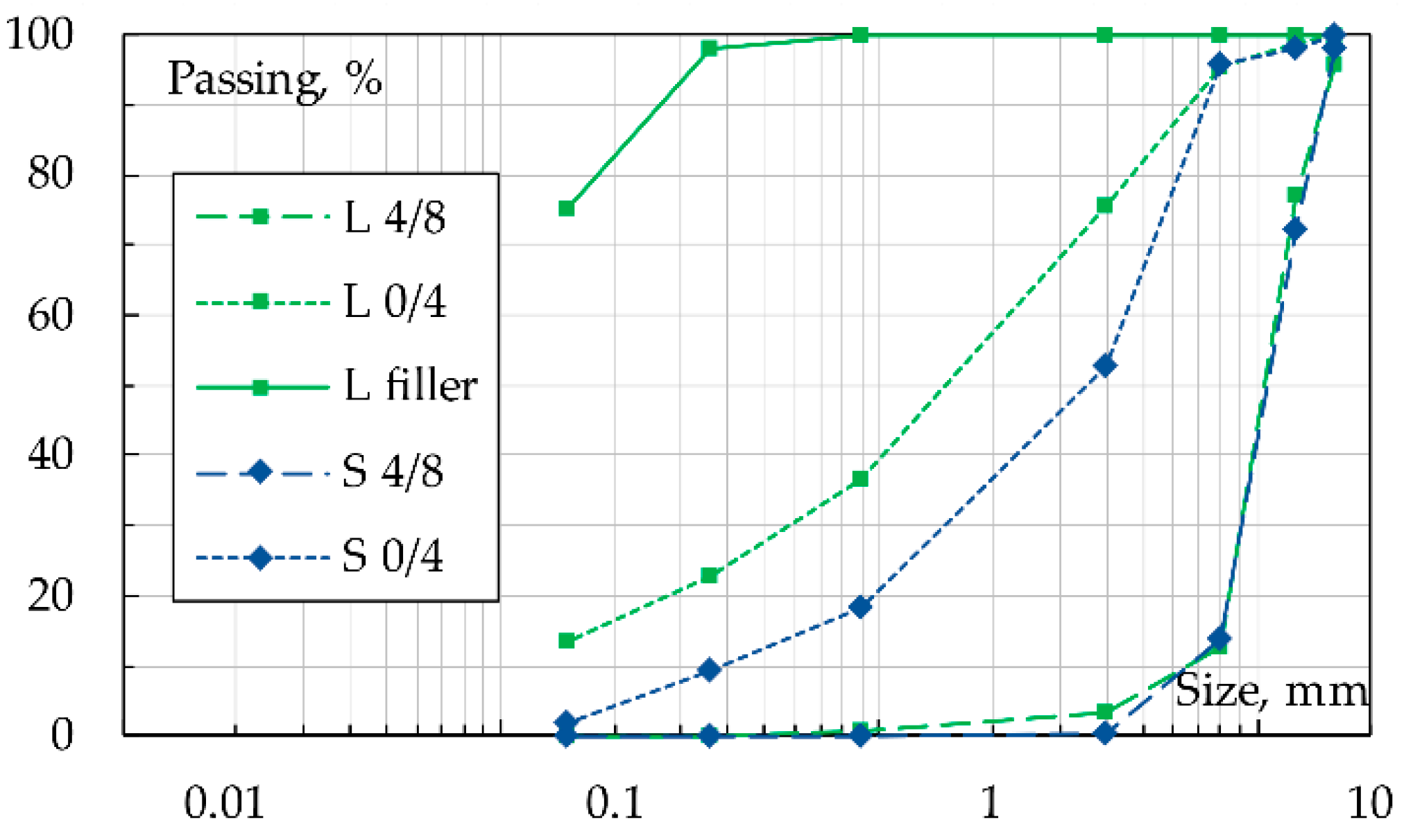
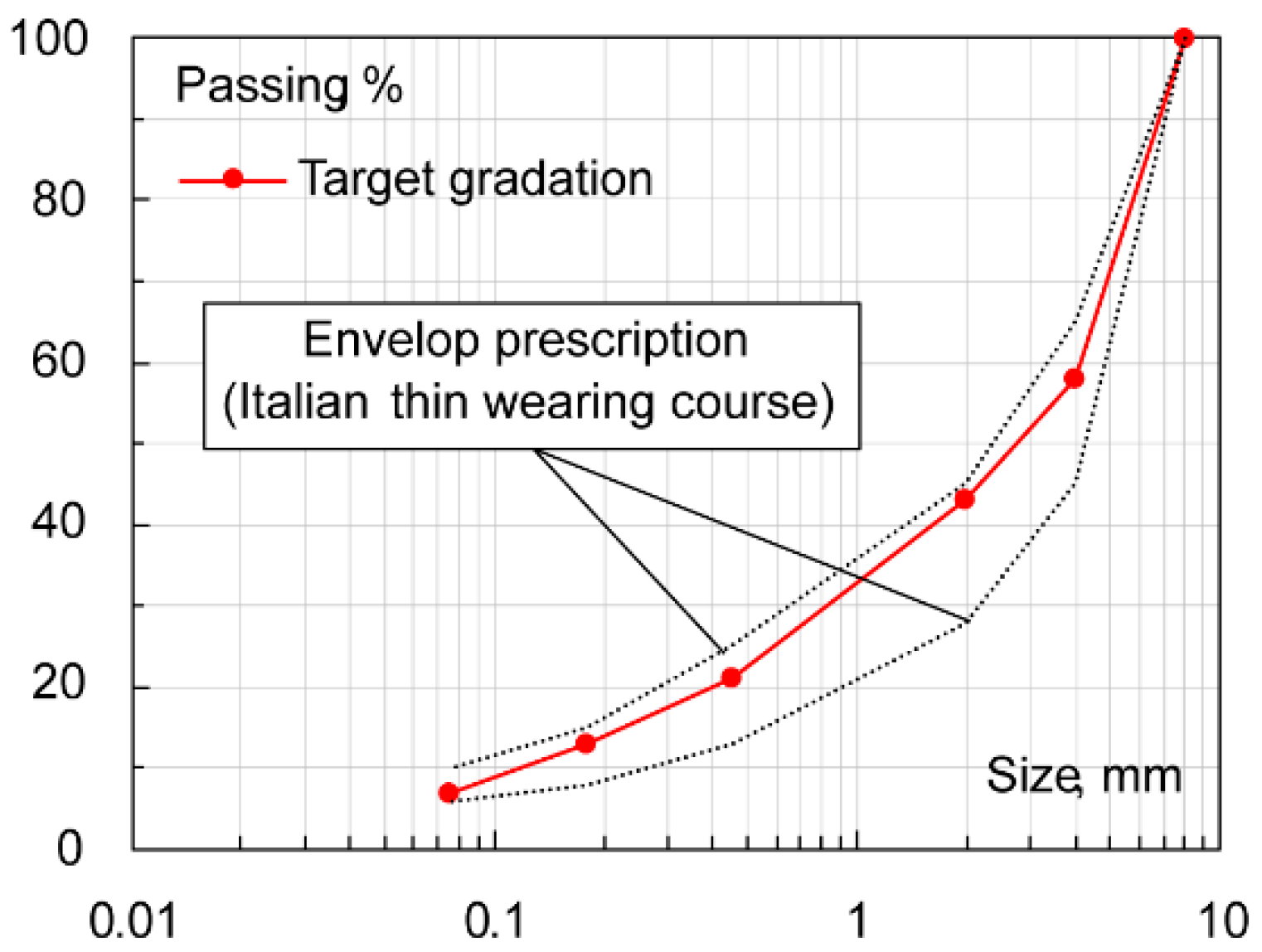
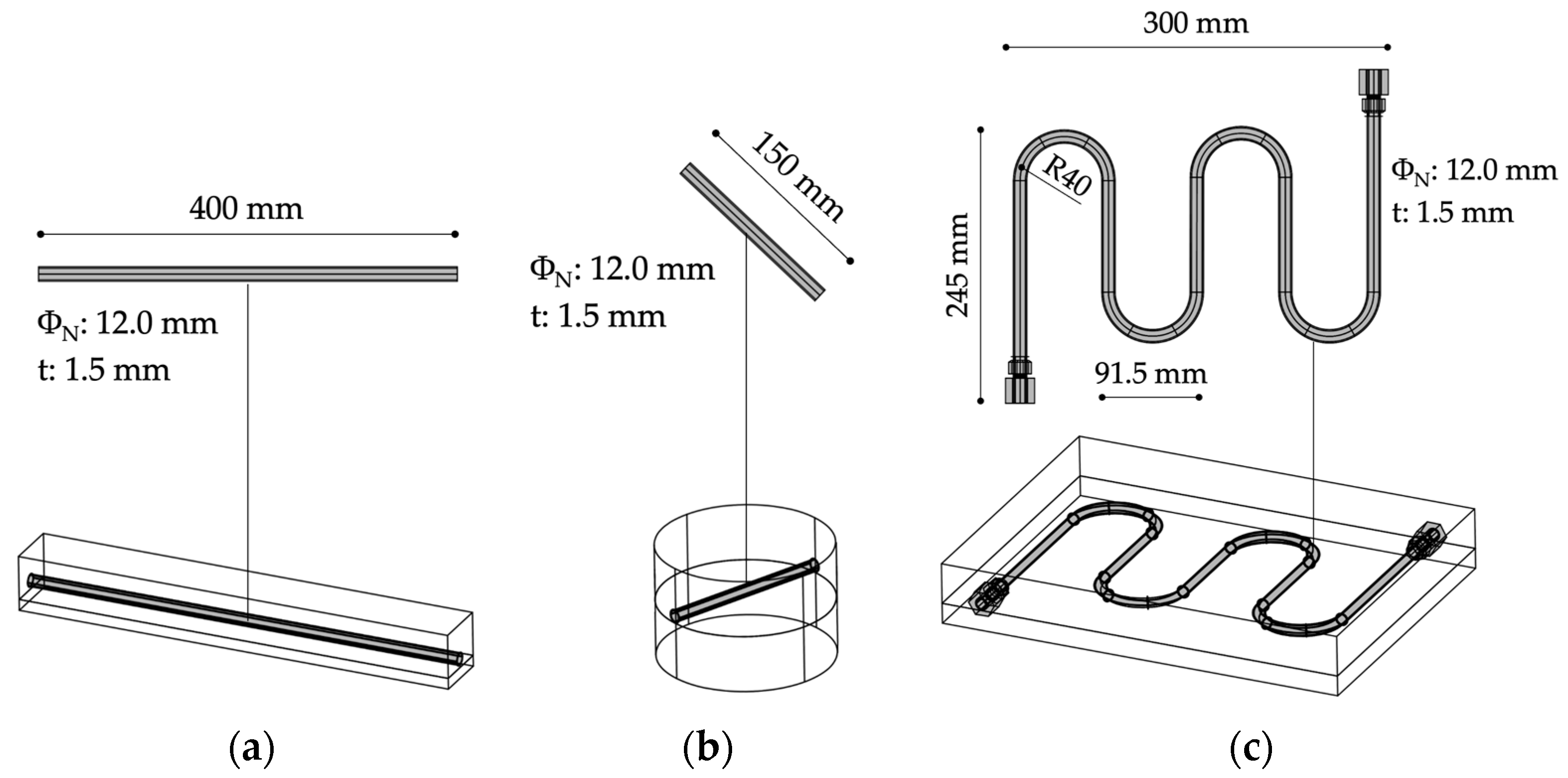


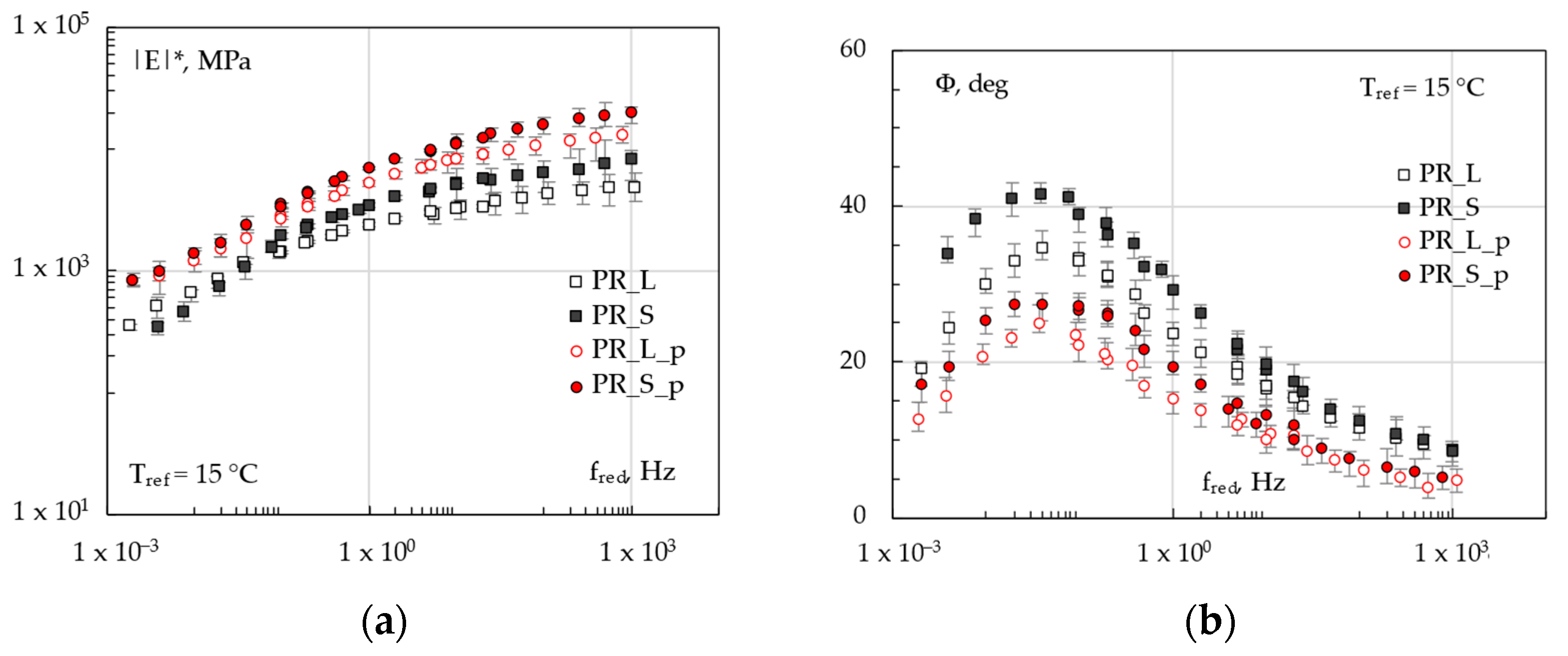


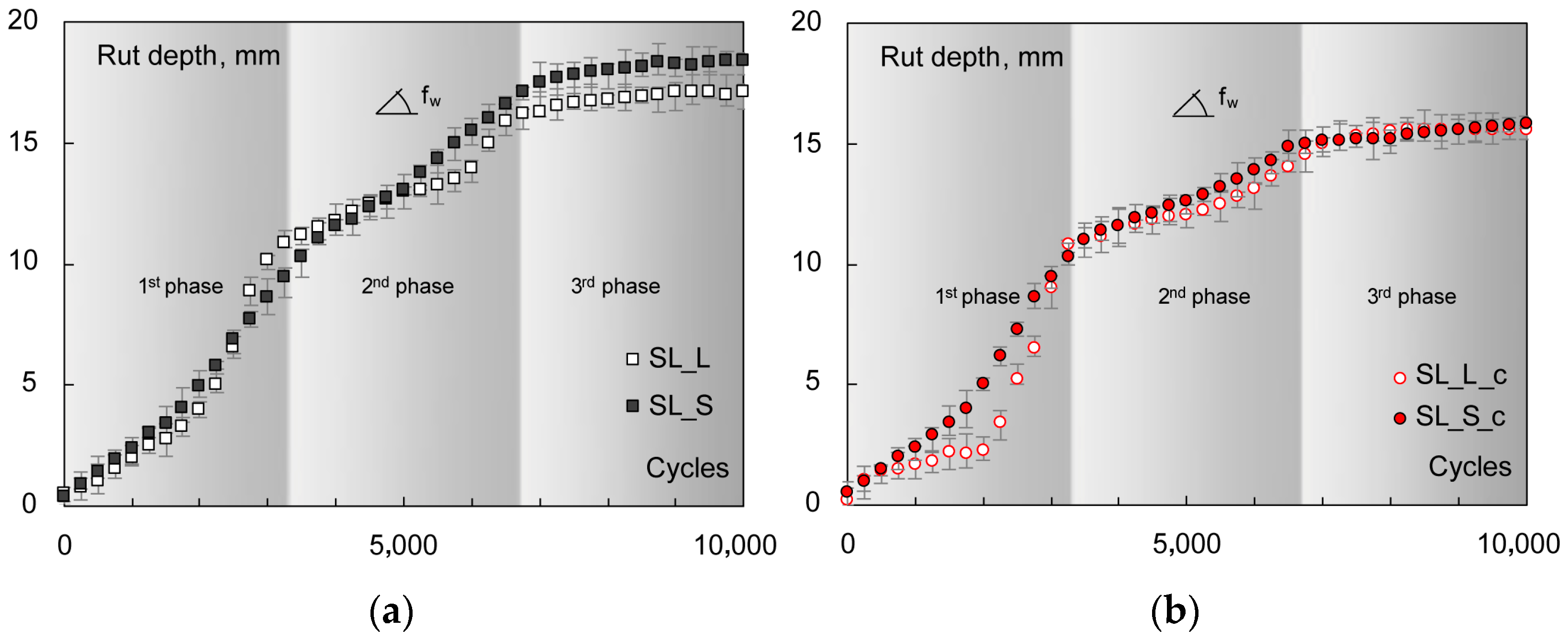
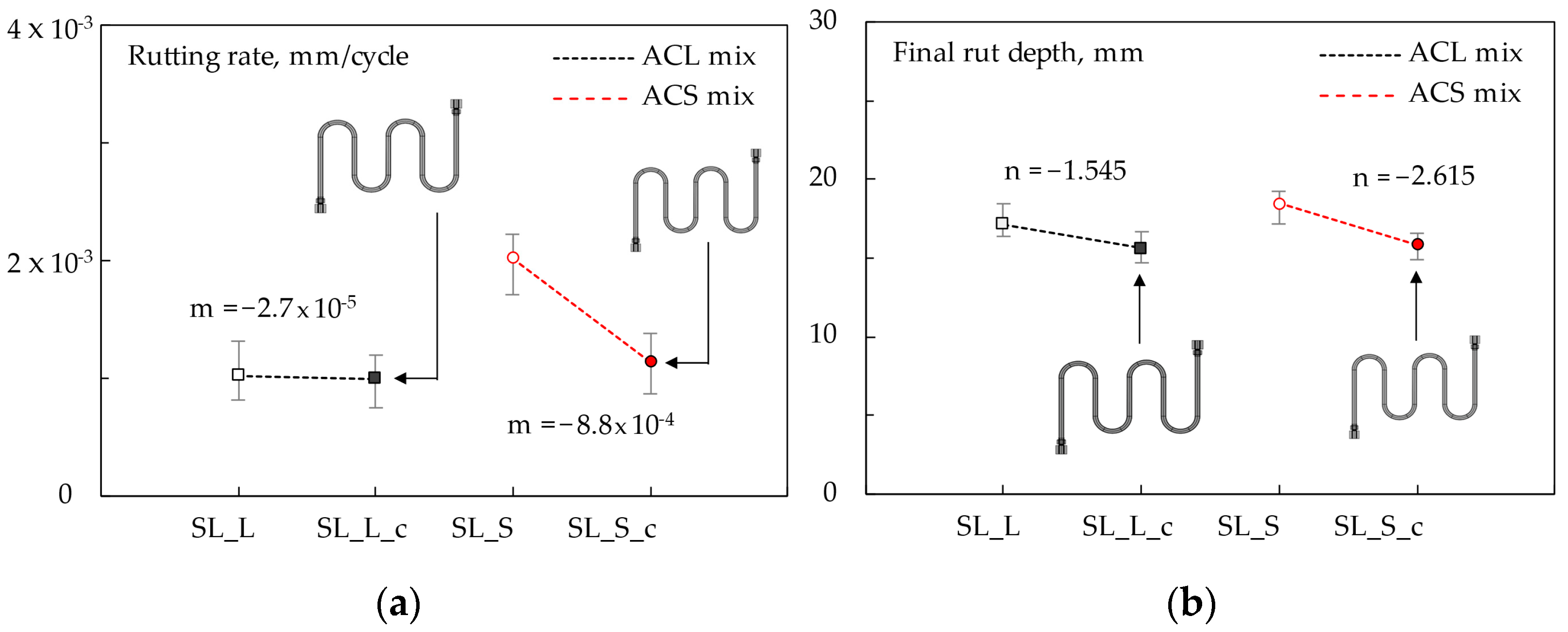
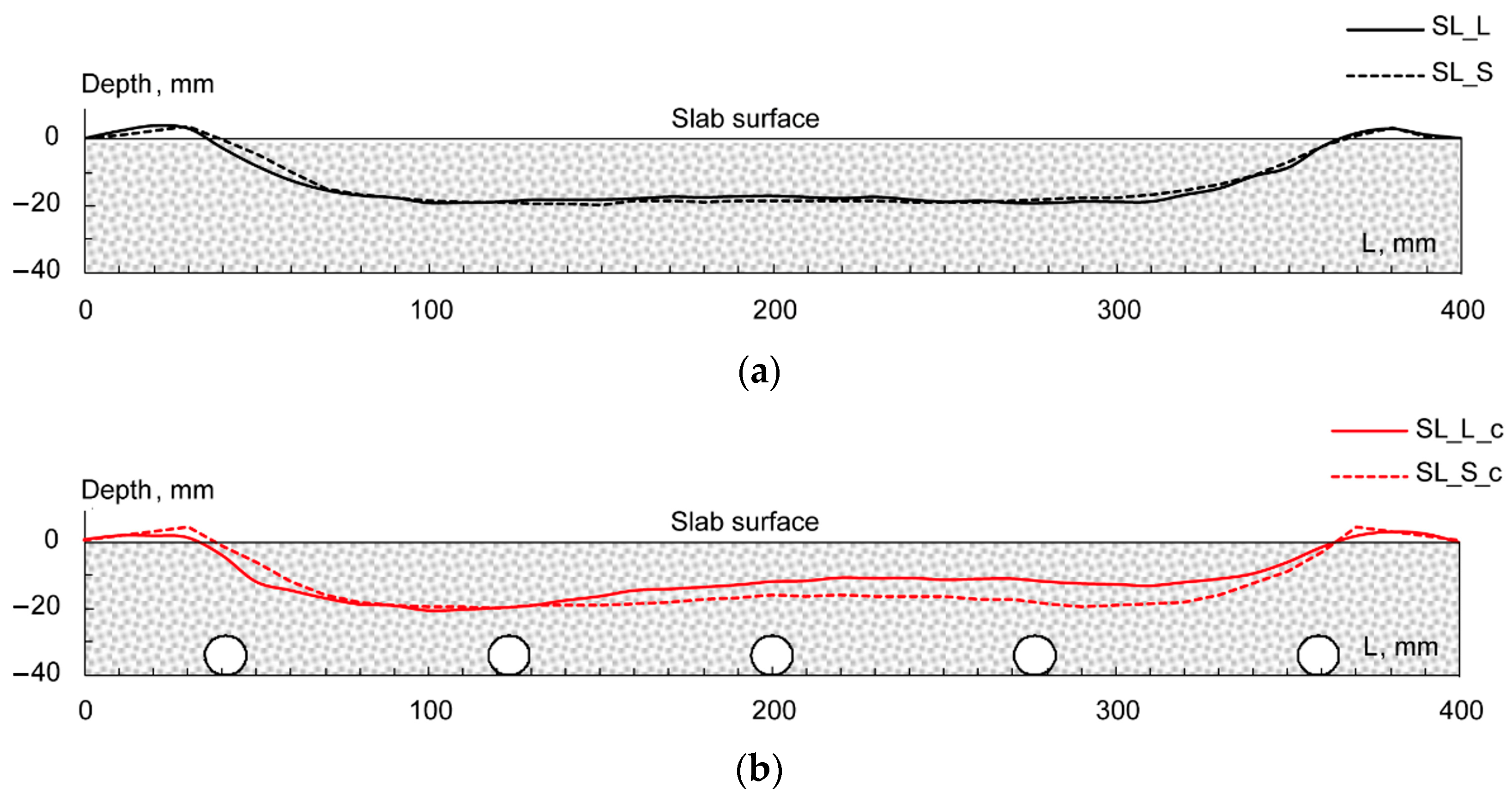
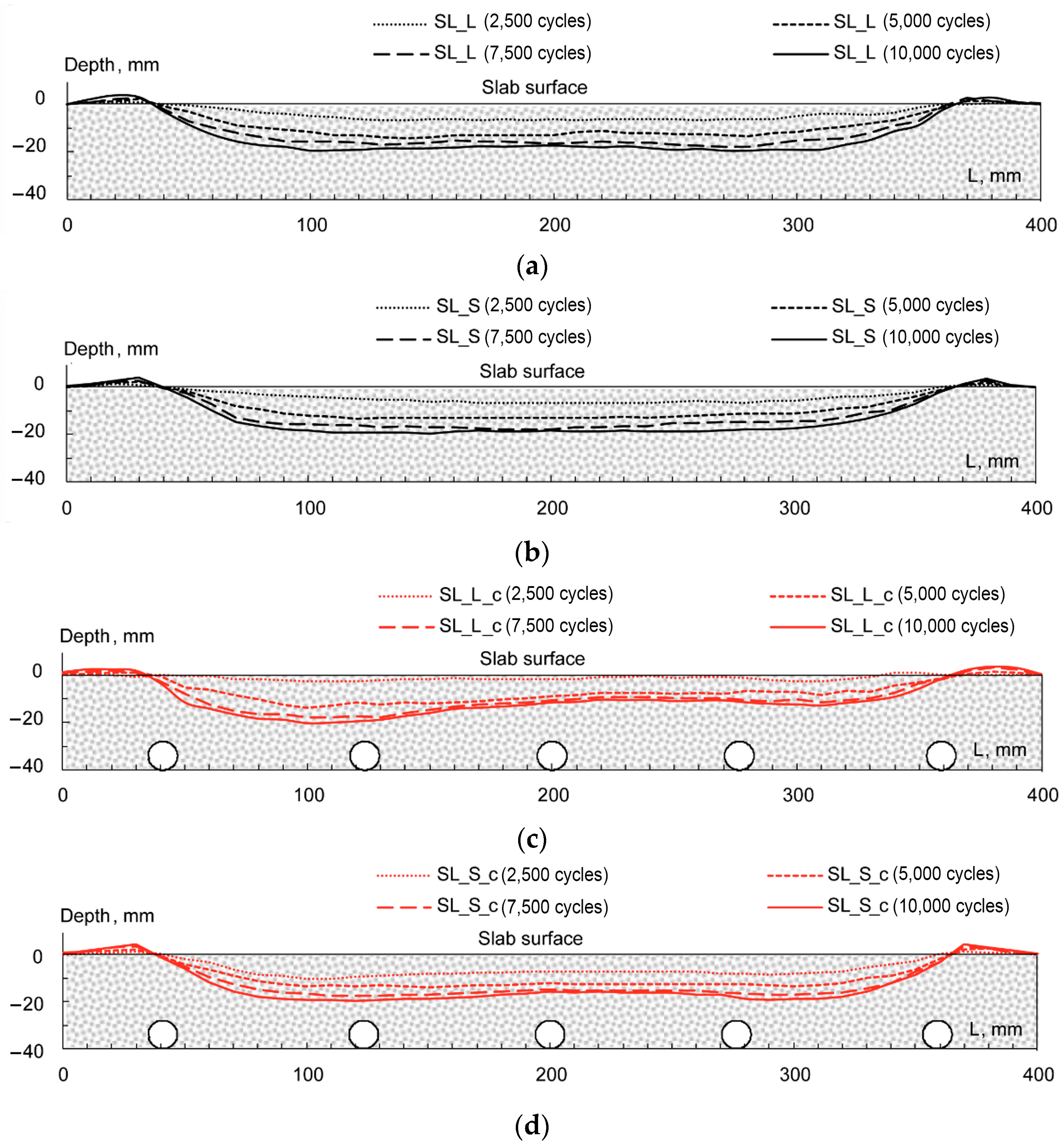
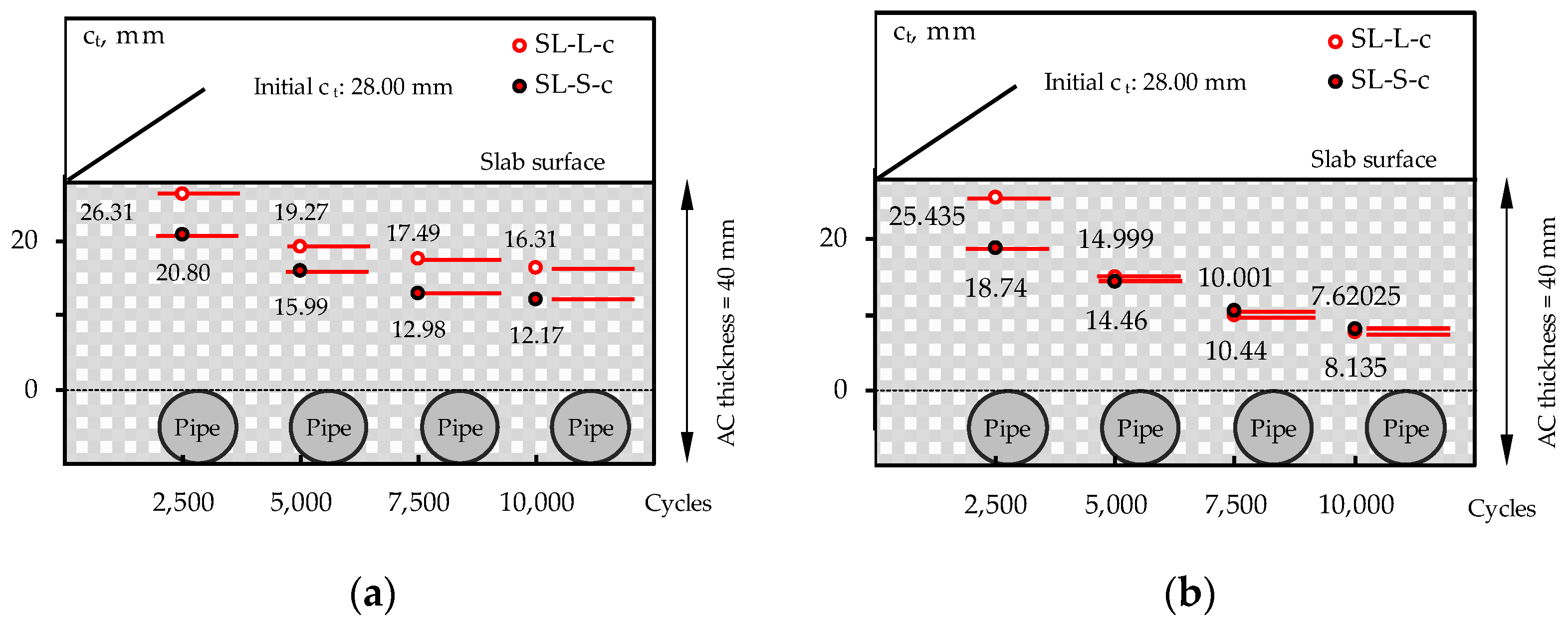
| Characteristic | Test Method | Unit | Value |
|---|---|---|---|
| Type | - | - | Non-modified |
| Penetration at 25 °C | EN 1426 | 0.1 mm | 53 |
| Softening point | EN 1427 | °C | 50.0 |
| Retained penetration at 25 °C after RTFO | EN 1426 | % | 70 |
| Increase in softening point after RTFO | EN 1427 | °C | 6.6 |
| Ductility at 25 °C | ASTM D113 | cm | >100 |
| Constituent | Dosages, % (by Weight) 1 | |
|---|---|---|
| ACL | ACS | |
| L 4/8 | 45.0 | - |
| S 4/8 | - | 42.0 |
| L 0/4 | 52.0 | - |
| S 0/4 | - | 51.0 |
| L filler | 3.0 | 7.0 |
| B content (by aggregate weight), % | 5.7 | 5.9 |
| Target voids, % | 4.00 | 4.00 |
| Code | Shape | Dimension | Procedure | Lower Layer | Collector | Upper Layer | ||
|---|---|---|---|---|---|---|---|---|
| Mix | h, mm | Mix | h, mm | |||||
| PR_L * | PR a | 50 × 400 mm | RC + saw | ACL | 10 | - | ACL | 40 |
| PR_S_p | ACL | 10 | Pipe 1 | ACL | 40 | |||
| PR_S * | ACS | 10 | - | ACS | 40 | |||
| PR_S_p | ACS | 10 | Pipe 1 | ACS | 40 | |||
| CY_L * | CY b | 150-mm diam. | SGC | ACL | 10 | - | ACL | 40 |
| CY_S_p | ACL | 10 | Pipe 2 | ACL | 40 | |||
| CY_S * | ACS | 10 | - | ACS | 40 | |||
| CY_S_p | ACS | 10 | Pipe 2 | ACS | 40 | |||
| SL_L * | SL c | 300 × 400 mm | RC | ACL | 10 | - | ACL | 40 |
| SL_S_c | ACL | 10 | Coil | ACL | 40 | |||
| SL_S * | ACS | 10 | - | ACS | 40 | |||
| SL_S_c | ACS | 10 | Coil | ACS | 40 | |||
| Property | Stress | CY_L | CY_S | CY_L_p | CY_S-P |
|---|---|---|---|---|---|
| fc, mm/cycle | 300 kPa | 4.33 | 3.655 | 2.683 | 1.091 |
| 350 kPa | 7.214 | 6.286 | 5.176 | 3.828 | |
| 400 kPa | 9.864 | 7.011 | 6.939 | 5.456 | |
| k1, - | 300 kPa | 7033 | 6193 | 5788 | 4506 |
| 350 kPa | 7847 | 9161 | 6719 | 5940 | |
| 400 kPa | 12,367 | 11,639 | 20,928 | 9786 | |
| k2, - | 300 kPa | 0.139 | 0.151 | 0.16 | 0.162 |
| 350 kPa | 0.143 | 0.136 | 0.15 | 0.165 | |
| 400 kPa | 0.108 | 0.101 | 0.109 | 0.116 | |
| FN, cycles | 300 kPa | 2875 | 3162 | 3317 | 4675 |
| 350 kPa | 1965 | 2098 | 2245 | 2813 | |
| 400 kPa | 854 | 977 | 1109 | 2579 |
| Property | SL_L | SL_S | SL_L_c | SL_S_c | |
|---|---|---|---|---|---|
| 1st phase | fw, mm/cycle | 2.20 × 10−3 | 2.48 × 10−3 | 1.05 × 10−3 | 2.91 × 10−3 |
| R2 | 0.93 | 0.98 | 0.88 | 0.95 | |
| 2nd phase | fw, mm/cycle | 1.02 × 10−3 | 2.02 × 10−3 | 9.93 × 10−4 | 1.14 × 10−3 |
| R2 | 0.98 | 0.99 | 0.95 | 0.99 | |
| 3rd phase | fw, mm/cycle | 2.53 × 10−4 | 2.48 × 10−4 | 1.29 × 10−4 | 2.61 × 10−4 |
| R2 | 0.86 | 0.91 | 0.84 | 0.98 | |
| Final rut depth, mm | 17.146 | 18.447 | 15.601 | 15.832 | |
Disclaimer/Publisher’s Note: The statements, opinions and data contained in all publications are solely those of the individual author(s) and contributor(s) and not of MDPI and/or the editor(s). MDPI and/or the editor(s) disclaim responsibility for any injury to people or property resulting from any ideas, methods, instructions or products referred to in the content. |
© 2022 by the authors. Licensee MDPI, Basel, Switzerland. This article is an open access article distributed under the terms and conditions of the Creative Commons Attribution (CC BY) license (https://creativecommons.org/licenses/by/4.0/).
Share and Cite
Pasetto, M.; Baliello, A.; Giacomello, G.; Pasquini, E. Rutting Behavior of Asphalt Surface Layers Designed for Solar Harvesting Systems. Materials 2023, 16, 277. https://doi.org/10.3390/ma16010277
Pasetto M, Baliello A, Giacomello G, Pasquini E. Rutting Behavior of Asphalt Surface Layers Designed for Solar Harvesting Systems. Materials. 2023; 16(1):277. https://doi.org/10.3390/ma16010277
Chicago/Turabian StylePasetto, Marco, Andrea Baliello, Giovanni Giacomello, and Emiliano Pasquini. 2023. "Rutting Behavior of Asphalt Surface Layers Designed for Solar Harvesting Systems" Materials 16, no. 1: 277. https://doi.org/10.3390/ma16010277
APA StylePasetto, M., Baliello, A., Giacomello, G., & Pasquini, E. (2023). Rutting Behavior of Asphalt Surface Layers Designed for Solar Harvesting Systems. Materials, 16(1), 277. https://doi.org/10.3390/ma16010277







